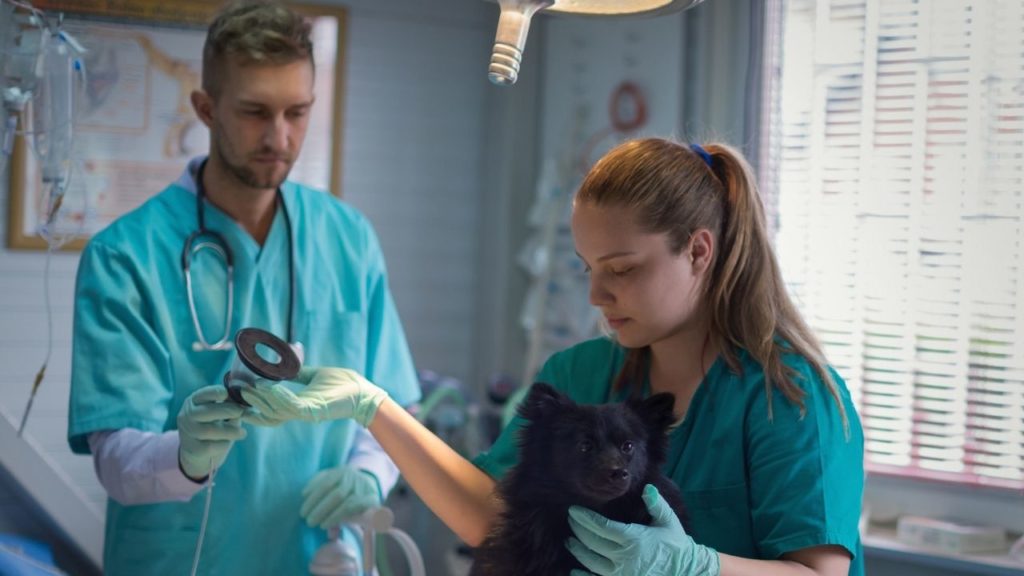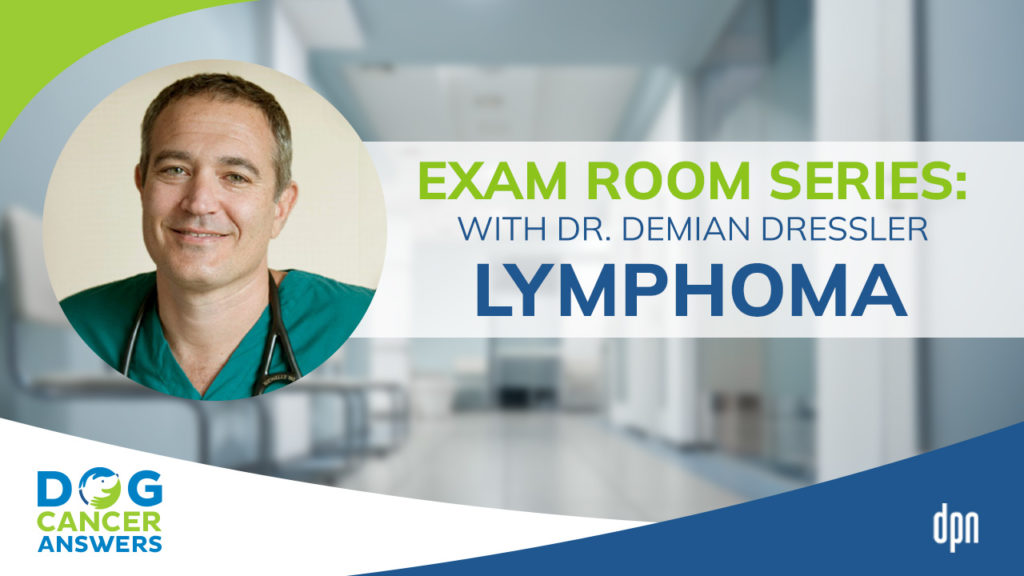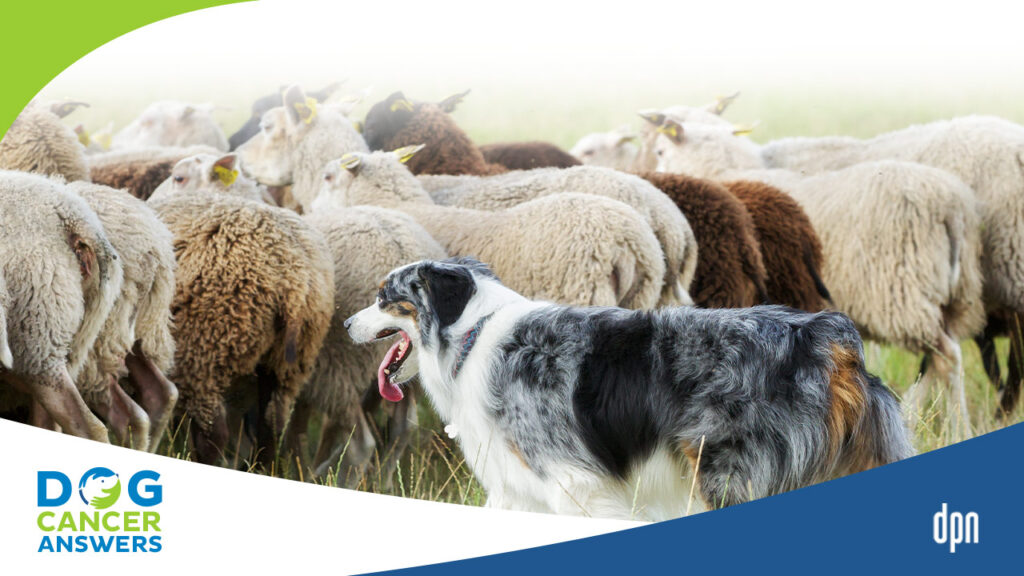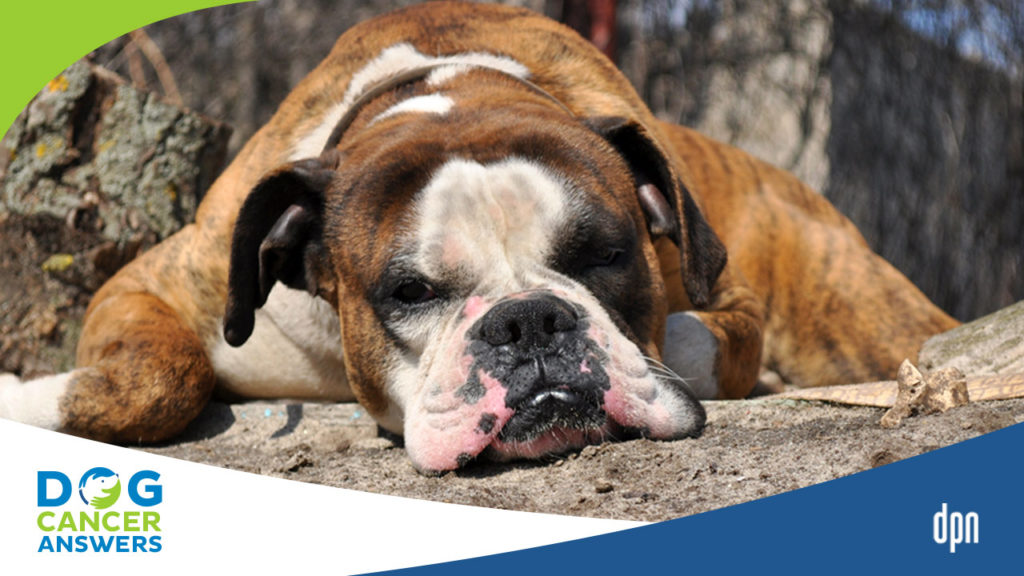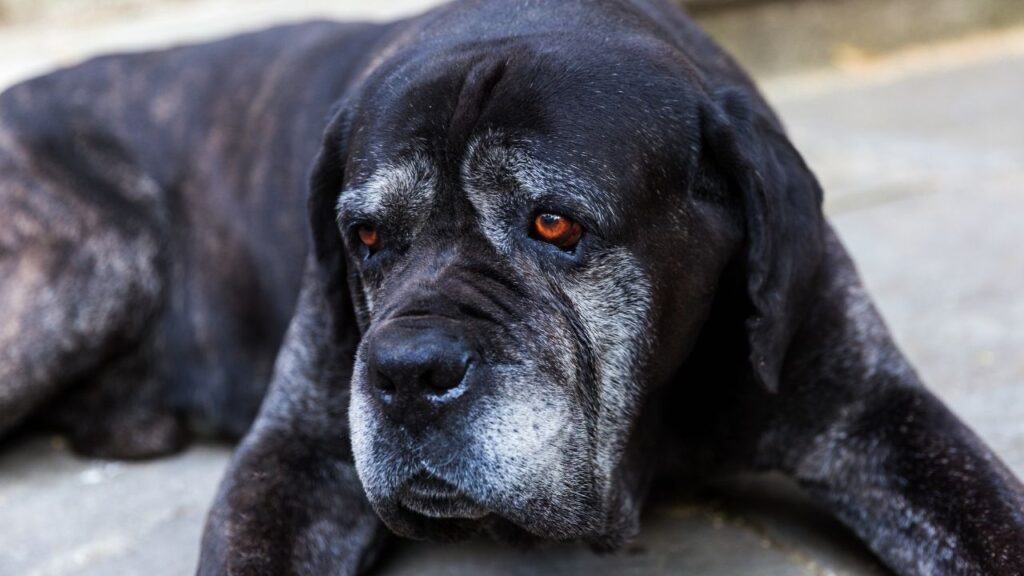Lymphoma -- also called lymphosarcoma -- is one of the most common cancers in dogs. There are over 30 different subtypes of lymphoma in dogs that show a wide variety of behavior, but many of them are very treatable.
Key Takeaways
- The life expectancy of dogs with lymphoma varies greatly and is based on many factors. In general, if left untreated, a dog with lymphoma may live a month, but dogs with certain types of lymphoma who are treated aggressively may live over two more years.
- The most common sign of lymphoma in dogs is enlarged lymph nodes. These will feel like round, firm lumps beneath your dog’s jaw, in front of his shoulders, in his armpits, in his groin, or behind his knees.
- Lymphoma is not generally cured, but with aggressive treatment, dogs can go into remission and have a good quality of life for many months.
- Most dogs are treated for lymphoma, either with medications to preserve quality of life or to go into remission (regression of the cancer). Once these treatments no longer work, your dog may start to feel sick, usually with signs such as lack of appetite, low energy, vomiting, diarrhea, and enlarged lymph nodes. When your dog with lymphoma no longer has a good quality of life, that may be the right time to euthanize.
Lymphoma in Dogs: A Systemic Cancer of the White Blood Cells
Lymphoma is cancer of the lymphocyte, a type of white blood cell. Lymphocytes travel all over the body in the bloodstream and the lymphatic system. This makes lymphoma in dogs difficult to “cut out,” because the cancer is a moving target.
However, this same movement makes lymphoma susceptible to chemotherapy, which also moves around in the bloodstream and infuses the lymph. This is why oncologists often say lymphoma is “highly treatable.”
Highly Treatable If Treated Quickly
The key is to catch it as early as possible and treat it aggressively. Left untreated, lymphoma kills very quickly, within weeks. With treatment, many dogs live a high-quality life for months and even years longer, depending upon the type of lymphoma.
If your dog has lymphoma, you probably have many urgent questions, the most important of which might be, “Is chemotherapy worth it?”
In this article, we will work hard to explain what you can expect if your dog has lymphoma so that you can make the best choices for your dog and your family, as soon as possible.
We will start with a short description of the lymphocytes themselves.
A Brief Overview of the Immune System
Normal lymphocytes circulate through your dog’s body, fighting and destroying invaders like bacteria, viruses, and toxins. There are two main types of lymphocytes: B-cells and T-cells.
- B-cells produce antibodies to target and destroy invaders (like bacteria and viruses).
- T-cells attack and destroy other cells that have already become infected or cancerous.
Lymphocytes travel through your dog’s bloodstream and the lymphatic system — a network of vessels that bring nutrients to cells and remove waste products.
Lymph Nodes Are Traps for Bad Things
Different branches of the lymphatic system come together at the lymph nodes, also called lymph glands.
The lymph nodes trap foreign invaders so the lymphocytes can destroy them.
Lymph nodes or glands are located throughout your dog’s body, deep inside and also close to the surface.
Your dog’s spleen, thymus (a gland near the heart where T-cells are made), and bone marrow are also considered lymphoid tissue.
Lymph nodes often swell when the body is fighting an infection. You have probably noticed that the two lymph nodes under your jaw (submandibular lymph nodes) may become larger and more tender when you have a cold. The same thing can happen to your dog.
The most common symptom of lymphoma in dogs is swollen lymph nodes.
Because lymphocytes circulate through your dog’s bloodstream and lymphatic system, when these cells become cancerous, they spread throughout your dog’s entire body. When a disease occurs everywhere like this, we call it “systemic.”
What Happens When Lymphoma Sets In
When a dog has lymphoma, the lymphocytes become cancerous and stop doing their jobs properly. The immune system has many bodily functions, and these immune cells serve important roles.
If left untreated, lymphoma can lead to:
- a low white blood cell count
- as a result, a higher risk of infection
- anemia
- clotting issues
- organ failure
Lymphoma can also affect the gastrointestinal (GI) tract, skin, or nervous system, but this is less common.
As lymphoma is left untreated, it progresses, and dogs get very sick quickly.
Dr. Demian Dressler explains why lymphoma is scary, but super treatable, and the "gained life expectancy" with treatment is more hopeful than other types of cancer.
Types of Lymphoma in Dogs
Lymphoma in dogs is incredibly common, accounting for up to 24% of all canine cancer diagnoses.1
We often call the most common type of lymphoma in dogs multicentric lymphoma, meaning it occurs in multiple lymph nodes throughout your dog’s body.
Multicentric lymphoma makes up 80% to 85% of canine lymphoma cases.2
There are several less-common types of lymphoma in dogs:2
- Gastrointestinal or alimentary lymphoma affects lymph nodes within the gastrointestinal tract, making up less than 10% of canine lymphoma cases.
- Mediastinal lymphoma affects lymph nodes in the chest near the heart, making up only a small fraction of canine lymphoma cases.
- Extranodal canine lymphoma occurs outside of the lymph nodes. The most common type of extranodal lymphoma is cutaneous – involving the skin.
- Indolent canine lymphoma refers to any low-grade, slowly progressing lymphoma that may not cause symptoms for a long time.
- Many other uncommon types and subtypes of canine lymphoma vary greatly based on cell types involved, location of symptoms, progression, and other factors. If your dog has one of these rare subtypes, your veterinarian or veterinary oncologist will be able to describe them for you.
Dr. Lauren Trepanier lost her own dog to lymphoma. She's determined to find the environmental causes so we can lower the incidence of this deadly disease.
What Causes Lymphoma in Dogs?
As with most cancer diagnoses, there is no one “known cause” of lymphoma in dogs. Cancer is a multifactorial disease, which means several things must go wrong for it to occur.
Several potential contributing causes have been studied, such as immunosuppression, exposure to certain chemicals, and viral or bacterial disease. Still, no strong link has been found to lymphoma development in dogs.3
Dogs of any breed or age can develop lymphoma, but some risk factors have been identified.
Risk Factors
There have been multiple studies to find dog breeds more at risk for lymphoma, but results are varied and non-conclusive overall. Some breeds appear more likely to develop lymphoma based on region, or based on lymphoma type, suggesting there is a genetic link.4
More studies are needed for more conclusive results, but the following dog breeds do appear to be more at risk for lymphoma:4
- Doberman
- Boxer
- Rottweiler
- Bernese Mountain Dog
- Golden Retriever
Studies done in people and dogs have found possible links between environmental factors and lymphoma. More studies are needed to make solid recommendations, but so far, the following links have been suggested:
- Exposure to herbicides and fungicides may increase the risk of canine lymphoma.5
- Environmental pollution, radioactive waste, and waste incinerators may increase the risk of lymphoma in certain dog breeds.6
- Air pollution may increase the risk of lymphoma in both dogs and people.7
Lymphoma Symptoms in Dogs
The symptoms of lymphoma in dogs vary based on the type of lymphoma, the severity, and where it is located in your dog’s body.
For the most common (multicentric) lymphoma, the symptom you are likely to notice at home is enlarged lymph nodes.
Normal lymph nodes often can’t be felt, so you may not realize your dog has them until they swell up.
You may feel enlarged lymph nodes with your fingers while petting your dog. They are lumps, firm but usually not painful. The lymph nodes that are easiest to evaluate are on the outside of the body and include:
- Submandibular lymph nodes (under each side of the jaw)
- Popliteal lymph nodes (behind each of the knees)
- Pre-scapular lymph nodes (in front of the shoulder blades)
- Axillary lymph nodes (in the armpits)
- Inguinal lymph nodes (in the groin)
After having multicentric lymphoma for a while, you may notice your dog is not acting like herself or not feeling well.
If she has lymphoma in another part of her body, the symptoms are usually associated with the affected body part. Some other symptoms of lymphoma include:
- Weight loss
- Poor appetite
- Lethargy
- Vomiting
- Diarrhea
- Fever
- Cough or difficulty breathing (if the mediastinal lymph node in the chest is affected)
- Ulcerated, oozy skin (if part of the skin is affected)
Most of these symptoms are non-specific, meaning they can occur with many different diseases. The presence of any one of these or any combination does not point toward cancer automatically, so if you notice any unusual lumps, or think your dog is not feeling well, bring her to your veterinarian for an examination.
Diagnosing Lymphoma in Dogs
When you bring your dog in for a lump, your veterinarian will want to do a thorough examination.
A physical exam will help your veterinarian check all of your dog’s lymph nodes and other vital signs. If lymphoma is suspected, here are some other tests that may be done:
- Bloodwork: This is often normal, even if the dog has lymphoma. However, it’s important to get blood tests done so your veterinarian can understand your dog’s general health. Also, mediastinal lymphoma can cause increased calcium levels, which would show up on bloodwork.
- A fine needle aspirate (FNA) and Cytology: A tiny needle is inserted into an enlarged lymph node to draw out a sample of the inside. That material can be looked at under a microscope. This test is quick, easy, and usually done during your appointment or soon after.
- Your veterinarian might see cancerous lymphocytes in the sample itself, in which case, lymphoma is very likely.
- Sometimes nothing helpful is seen on the microscope, even if your dog does have lymphoma. We call this a non-diagnostic sample.
- Biopsy: A piece of an enlarged lymph node is surgically removed and sent to a lab for testing. This is more expensive than a fine needle aspirate cytology, but you can get more detailed information from a biopsy than from cytology.
Staging Lymphoma to Get a Prognosis
The prognosis (or likely outcome) for dogs with lymphoma varies based on many factors, including what kind of lymphoma it is, where it is located, and how far it has already progressed.
- Without any treatment, the median survival time for dogs with the most common types of lymphoma is about one month.
- The dogs with the most common type of multicentric lymphoma, getting the most aggressive chemotherapy (see below), have an average survival time of 1 year.
- However, each dog is unique: Up to 20% of dogs with that same type of lymphoma and the same type of chemotherapy get more than two years of survival time.1
Your veterinarian and/or oncologist will want to stage your dog’s lymphoma. Staging (determining how severe the cancer is) can be useful for figuring out the dog’s prognosis and can sometimes impact treatment decisions.8
Stage I – one lymph node is involved
Stage II – multiple lymph nodes involved, but only on half the body
Stage III – multiple lymph nodes involved on both sides of the body
Stage IV – liver and/or spleen involved
Stage V – other organs (such as bone marrow, skin, nervous system, and/or gastrointestinal tract) are involved
The above stages can be further divided into substages, which is very important to prognosis:8
Substage A means that the dog feels fine at the time of diagnosis.
Substage B means that the dog feels sick at the time of diagnosis.
In general, dogs who feel sick at the time of diagnosis have a worse prognosis than dogs who still feel normal.
Dogs still feeling good when their lymphoma is discovered generally respond better to treatment.8
Staging Tests for Lymphoma in Dogs
Your veterinarian or veterinary oncologist may recommend more tests to help determine the stage, or where the lymphoma is in your dog’s body.
Most of these tests are to look for affected lymph nodes inside your dog’s body or to look at his health in general. Tests used to stage lymphoma in dogs include:
- Bloodwork
- Urinalysis
- Chest radiographs (x-rays)
- Ultrasound
- Bone marrow biopsy or aspirate
Immunophenotyping: B-cell or T-cell?
Immunophenotyping is a specific laboratory test to determine if your dog’s lymphoma is in the B- or T-cells.
Knowing this information may provide good information on prognosis, or how well your dog may respond to treatment.
Dogs with B-cell lymphoma typically respond better to chemotherapy and have longer remissions, and longer survival times, than dogs with T-cell lymphoma.9
Staging Lymphoma Adds Up Quick
Staging can get quite expensive, so this is an area where you can weigh the pros and cons.
- The pros of staging are that you and your dog’s veterinary team will have a complete picture of your dog’s health and what parts of his body are affected by cancer. This information can give you a more accurate prognosis and might also rule in or rule out some treatment options.
- The cons are that it is expensive and does not always give information that will change your decision. If you have limited funds, allocating your money for treatment may be the better choice.
Tip: Have an Oncologist Oversee or Conduct the Staging
Lymphoma is very common, as noted above, and there are several treatment strategies, as you will see in a moment. Because there is a need to move quickly, especially if you have limited funds, doing as many staging tests as possible with an oncologist is a good idea.
They will know best which staging tests are critical, and which can be skipped in favor of having money to treat lymphoma. Dr. Ettinger suggests having cytology done with your veterinarian, and if it is positive for lymphoma, getting an oncologist involved for biopsies and other testing.
Treating Dog Lymphoma: Move Fast!
For most cancer types in dogs, you have time to research and think things through. But most types of lymphoma are aggressive and will progress rapidly, so if you think you will treat your dog’s lymphoma with chemotherapy, it is important to get started right away.
Is There a Cure for Lymphoma in Dogs?
It is very rare to cure lymphoma in dogs forever. However, with the proper treatment, many dogs with lymphoma can achieve remission (regression of cancer) for many months to years.
It’s important to note that most of these dogs will have an excellent quality of life during this time.3
Chemotherapy in Dogs with Lymphoma
Without question, chemotherapy is the treatment of choice for lymphoma in dogs. There are a variety of drugs and protocols available, as you will see below. Before we get into the details, let’s review a few general things you should consider.
Changes are Common and Even Expected
Many people worry that if they choose to do chemotherapy, they are committing to an entire course of treatment as described by their oncologist.
But this is not necessarily true. Your dog’s oncologist can and will adjust the treatment plan as needed even after starting treatment, and you can always change your mind, too.
Multiple Drugs Are Often Used
Many chemotherapy protocols for canine lymphoma involve multiple drugs repeated in cycles. This is because the weakest cancer cells tend to die off early in treatment, leaving stronger cancer cells still alive in the body. Using multiple drugs in rounds of chemo that work slightly differently kills as many cancer cells as possible.
Remission Is Quick, and Eventual Relapse Is Probable
Lymphoma in dogs is usually very responsive to chemotherapy, and many dogs will go into remission, or regression of the cancer. This can happen quickly, even after just a couple of rounds of chemotherapy, which is another reason why oncologists call lymphoma in dogs “highly treatable.”
However, in almost all cases, there will eventually be a relapse or recurrence of the cancer. The length of remission varies (see below).
Rescue Protocols May Help
When a relapse happens, chemotherapy can be repeated. This is often called a “rescue” protocol.
Most dogs will get another (second) remission with more chemotherapy, which usually does not last as long. Rescue protocols can be implemented multiple times with the same or different drugs until cancer no longer responds to chemotherapy.
Switching Chemo Drugs Quickly
If your dog does not respond to the recommended chemotherapy treatment fairly quickly, your veterinary oncologist will likely switch to another protocol or combination of drugs.
Each dog, and each cancer, responds a little differently. You may need patience and a flexible mindset as your oncologist suggests a new action.
Acute Tumor Lysis Syndrome
Dogs with a high amount of cancer in the body are at risk for acute tumor lysis syndrome. This uncommon but life-threatening complication usually occurs within 48 hours of the first chemotherapy treatment.
If chemotherapy successfully kills many cancer cells, the damaged cells break down. Their pieces become waste products, which overwhelm your dog’s body.
Acute tumor lysis syndrome can cause vomiting, diarrhea, lethargy, collapse, abnormal heart rate, kidney failure, twitches, and difficulty breathing. It’s a life-threatening condition and requires hospitalization and supportive therapies to help your dog’s body eliminate all those dead cancer cells.
Most dogs can go home after they receive their chemotherapy treatments. But if your veterinarian determines your dog is at high risk for acute tumor lysis syndrome, plan for your dog to stay in the hospital overnight after the first chemotherapy treatment. That way, she can get supervision and treatment if needed.10
Common Chemotherapy Treatments for Canine Lymphoma
There are many different types of chemotherapy medications, and they are used in many different combinations. Each oncologist has their favorites.
New medications and new combinations of drugs are constantly tested for lymphoma because it is the most common cancer in dogs. We cannot go through all of them here, although we will keep this article updated with the most current strategies.
Your dog’s oncologist is best positioned to determine which protocols to use with your dog’s specific case and to tell you the latest up-to-the-minute updates about what the field knows.
Meanwhile, here are some of the most used first-line chemotherapy protocols.
The University of Wisconsin CHOP Protocol
This protocol was developed at the University of Wisconsin and is the gold standard for canine lymphoma. Treatments are usually once a week for 19 weeks (about 4 and a half months), rotating through the different medications.
CHOP is an acronym for the drugs used:
Using CHOP, 90% of dogs go into complete remission within the first few weeks. Complete remission means no evidence of cancer in the dog’s body.
- Remission usually lasts 4-6 months after completing the full treatment.
- If (when) a relapse occurs after treatment, 90% of dogs achieve a second remission when CHOP is started again.
- The median survival time with CHOP is 13-14 months.
CHOP is usually well-tolerated. Side effects can include vomiting, diarrhea, nausea, and a low white blood cell count. Most side effects can be prevented or managed at home with supportive medications. Less than 5% of dogs require hospitalization.
CHOP can be very expensive, potentially costing upwards of $10,000.11
Doxorubicin
Doxorubicin is also known as hydroxydaunorubicin or the brand name Adriamycin. It is part of the CHOP protocol and can also be given alone. When used alone, treatments are usually once every 2-3 weeks for five or six total doses.
- 60-80% of dogs will go into remission with doxorubicin alone.
- The median survival time is 7-9 months.
Doxorubicin can cause cardiotoxicity or damage to the heart. Some veterinarians recommend coenzyme Q10 during treatment, or dexrazoxane right before treatment, to help protect the heart.
Doxorubicin may be given slowly as an infusion to lessen the effect on the heart.12,13,14 If heart toxicity is a concern for your dog, your oncologist may want to use another chemotherapy agent in doxorubicin’s place.
Prednisone
Prednisone is a relatively inexpensive and easy-to-obtain oral steroid often prescribed for lymphoma in dogs. It can help slow the progression of most types of lymphoma but is not as effective overall as chemotherapy drugs and protocols.
Prednisone is part of the CHOP protocol and is commonly combined with other chemotherapy drugs such as Laverdia.15
Prednisone is an inexpensive tablet that can be given at home and will often make your dog feel much better quickly and improve her quality of life.
- There is a 50% remission rate for lymphoma in dogs with prednisone used alone.
- Median survival time on prednisone alone is 2-3 months.
Some general practice veterinarians will prescribe a dog with lymphoma prednisone right away to inexpensively and quickly help your dog feel better. However, this is not a good idea if you want to pursue CHOP or other chemotherapy drugs. Starting prednisone before introducing other drugs can make the chemotherapy drugs less effective.
If you think you want to pursue chemo with an oncologist, wait to start a steroid until you see them. However, if you know you do not want chemotherapy, prednisone is a good alternative.
The best advice is to talk to your family, and the oncologist, quickly and before making any big treatment decisions.16
Tanovea (rabacfosadine)
Tanovea is the first FDA-approved treatment for canine lymphoma, approved in July 2021. It is injected into a vein once every three weeks for five treatments total.
- 70% of dogs achieve remission.
- The median survival time is 4-6 months.
- One round of Tanovea is about as expensive as one round of CHOP, but the protocol is shorter, with fewer hospital visits.
A recent study looking at alternating Tanovea with doxorubicin every three weeks for a total of three treatments showed results as good as a full CHOP protocol. Researchers are also seeing if Tanovea can be used as part of a CHOP protocol to improve survival times.17
Laverdia-CA1 (verdinexor)
Laverdia is an oral tablet given at home twice a week. It received conditional approval from the FDA in January 2021.
The median survival time for dogs taking Laverdia is about three months, with 30% of dogs surviving up to nine months. It costs about $200 a month.
Laverdia can also be used as a “bridge” to tide your dog over until traditional chemotherapy is started and does not interfere with the effectiveness of traditional chemotherapy.17
Chemotherapy Rescue Protocols
A “rescue” chemotherapy protocol is used when the first-line treatment options fail and your dog relapses. Sometimes the rescue protocol is a repeat of the first-line treatment. If those don’t work or your oncologist suspects they won’t work, they may use one of the protocols below.
These protocols are currently less popular but may be successful where other options fail. Rescue protocols like these and others your oncologist may suggest are typically used until they stop working, possibly after just a few cycles.
Your dog’s oncologist may also have some reason to recommend one of these protocols as a first-line treatment, but that is less common.15
MOPP or MVPP
MOPP is an acronym for Mustargen, Vincristine/Oncovin, Prednisone, and Procarbazine. This protocol combines oral and injected medications over a 14-day cycle.
It has a 65% chance of remission and may be recommended for multiple cycles if effective.
LOPP
This is an acronym for the drugs Lomustine/CCNU, vincristine/Oncovin, Prednisone, and Procarbazine. This protocol is similar to MOPP.
It has a 60% chance of remission and is similar in length of cycle, and may be recommended for multiple cycles if it is effective.
Dacarbazine
This drug is given IV every 2-3 weeks and can be combined with other medications. It has a 35% chance of remission.
Mitoxantrone
Mitoxantrone is given by injection every three weeks for up to six treatments. There is a 50% chance of remission, with most responses lasting about three months.
L-asparaginase (L-spar) and Prednisone
This combination of L-asparaginase (Elspar or L-spar) and prednisone/prednisolone is highly effective and affordable, but the response duration is short. It’s less likely to cause side effects but may become less effective over time.
L-asparaginase (L-spar) and CCNU/Lomustine
This is a combination of injection and oral medication given every three weeks. There is an 80-90% chance of remission, with responses usually lasting two months. It may be more expensive and may have more side effects.
Procarbazine, prednisolone, and cyclophosphamide (PPC)
These three medications can be given at home on a daily basis as a combination chemotherapy protocol. In one study, 24% of dogs had a partial response, and 46% achieved complete remission.18
Actinomycin-D
This chemotherapy drug is given by injection once every three weeks for a total of five treatments. About 40% of dogs achieve remission, lasting a median of four months.19
Surgery
Surgery is the treatment of choice for most cancers, but it is usually ineffective for systemic cancers such as lymphoma.
Your veterinarian may recommend surgery to remove a very large lymph node that is causing your dog discomfort or pain. Still, lymph nodes often shrink dramatically with chemotherapy, so surgery might not be offered right away if you pursue chemo.
Radiation
Radiation is not commonly used to treat lymphoma but can be useful in some cases for palliative care (helping, not curing) or for transplants.
Palliative Care
Radiation may help relieve symptoms of enlarged lymph nodes obstructing your dog’s airway, or pinching nerves or the spinal cord. These dogs generally get 4-6 weekly treatments in addition to chemotherapy.
Half Body Radiation
Half the body is irradiated, then the other half is irradiated at the next appointment. The radiation will kill cancer cells and healthy rapidly dividing cells — such as in the GI tract and bone marrow — which is why half of the body is done at a time. When combined with CHOP chemotherapy, half-body radiation can add five months to the median survival time. Since half-body radiation can make your dog feel very sick, some veterinary oncologists do not recommend it.20,21
Total Body Radiation/Bone Marrow Transplant
Similar to a bone marrow transplant procedure in humans, your dog will first have chemotherapy and then be treated with a medication called Neupogen to stimulate the release of stem cells from the bone marrow.
These stem cells will be collected and held while your dog has full body radiation to kill any hiding cancer cells. The stem cells are immediately returned to your dog to repopulate the bone marrow. Dogs can also receive stem cells from a healthy matching donor dog.
This is a costly procedure and not a good fit for most dogs, but 30% of treated dogs remain cancer-free two years after treatment.
Immunotherapy
Immunotherapy is an emerging option for treating lymphoma in dogs.
Monoclonal antibodies bind to cancer cells to alert the immune system to attack them. Two monoclonal antibody drugs, AT-004 and AT-005, received conditional approval from the USDA for treating canine lymphoma, but haven’t performed as well as expected.22
Adoptive T-cell transfer activates the dog’s T-cell lymphocytes to attack cancer cells. The exact process can vary depending on the company used, but generally, a blood sample is sent out for T-cells to be cultured and activated. The T-cells are then given back to the dog via infusion. The process takes 3-6 weeks. Two companies currently offering this service are Aurelius Biotherapeutics and Elias Animal Health (Elias creates a vaccine from the dog’s tumor first, as an added layer of immune therapy).22
Oncolytic virotherapy is when a specialized virus targets cancer cells. There have been some promising laboratory studies, but no therapies are available yet for dogs.22
Immunomodulators, or cytokine therapy, enhance a dog’s immune response to cancer. Some preliminary studies have been done, but no therapies are available yet for dogs.22
Immune checkpoint inhibitors, or immune checkpoint blockade, interfere with some cancer cells’ ability to hide from the immune system. Studies are underway, but there are currently no therapies available for dogs.22
Vaccine
There is no vaccine to prevent canine lymphoma. However, two vaccines can be used in the treatment of canine lymphoma.
Tel-eVax® is a genetic vaccine targeting telomerase, an enzyme that helps prevent cancer cells from dying. Tel-eVax has shown improved survival times for dogs with B-cell lymphoma when combined with chemotherapy.24
APAVAC is an autologous vaccine (meaning it is made for each dog after a lymph node biopsy) that has also shown improved survival times for dogs with B-cell lymphoma when combined with chemotherapy.23
Diet
There are no specific dietary recommendations for dogs with lymphoma. The most important thing is that your dog eats a balanced diet.
Supplements
There is no specific supplement that will help treat lymphoma, but there are supplements that might be helpful for your dog when they have cancer in general.
Always consult your veterinarian before adding a supplement to ensure that it is a good fit for your dog and won’t interfere with any of her medications or treatments.
In lymphoma cases where dogs receive expensive chemotherapy treatments, oncologists may discourage using supplements, at least while chemotherapy is done. This could be for several reasons, including making sure that the side effects your dog experiences are from chemotherapy, not from a new supplement being introduced.
Working with a veterinarian well-versed in supplements and other aspects of health can help your veterinarian and oncologist strategize on what to use and when.
Integrative Therapies for Dogs with Lymphoma
Various alternative therapies can play a role in lymphoma treatment.
While acupuncture does not directly target cancer, it can be useful to help improve quality of life. Clinical trials in humans have shown that acupuncture helped reduce nausea from chemotherapy. Veterinarians use acupuncture to relieve pain and nausea in dogs.
Homeopathy may be supportive and not interfere with other treatments. A 2010 retrospective study looked at dogs and cats treated with homeopathy, and 40% of the dogs with lymphoma showed improvement, according to their owners, while 6.7% got worse.25 More studies are needed to determine if homeopathy improves the quality of life and symptom relief in dogs.
Prevention Strategies for Lymphoma
There is no guaranteed way to prevent your dog from getting lymphoma, but there are things you can do to decrease risk.
- Reduce the use of pesticides around your home
- Reduce use of chemical cleaning products within your home
- Keep your dog out of the house when painting to prevent exposure to paint fumes
What the End of Life Looks Like for Dogs with Lymphoma
Canine lymphoma is very rarely cured completely. In most cases, the best-case scenario is a long remission.
The good news is that many dogs can have a good quality of life for many months to a few years.
Many dogs will undergo several rounds of treatments (usually chemotherapy) with cycles of remission and relapse in between until cancer does not respond to treatment anymore.
At that point, your dog will begin to feel very sick. In most cases, at that point dog lovers consider euthanasia the kindest option.
This True Tail features Indy's mom AND his veterinarian, telling his epic tale of fighting lymphoma and helping all of our dogs by participating in the Golden Retriever Lifetime Study.
- Mingus, L. (2021) Lymphoma in dogs, Flint Animal Cancer Center. Colorado State University Veterinary Teaching Hospital. Available at: https://www.csuanimalcancercenter.org/2019/11/06/lymphoma-in-dogs/ (Accessed: April 15, 2023).
- Fan, T.M. (2023) Canine lymphoma – circulatory system, Merck Veterinary Manual. Merck Veterinary Manual. Available at: https://www.merckvetmanual.com/circulatory-system/canine-lymphoma/canine-lymphoma (Accessed: April 15, 2023).
- Werling Comparative Oncology Research Center (2021) Canine lymphoma research, Purdue University College of Veterinary Medicine. Available at: https://vet.purdue.edu/wcorc/cancer-research/canine-lymphoma-research.php (Accessed: April 15, 2023).
- Comazzi, S. et al. (2018) Breed-associated risks for developing canine lymphoma differ among countries: An European canine lymphoma network study, BMC veterinary research. U.S. National Library of Medicine. Available at: https://www.ncbi.nlm.nih.gov/pmc/articles/PMC6090884/ (Accessed: April 15, 2023).
- Schofield, I. et al. (2019) “Geographic distribution and environmental risk factors of lymphoma in dogs under primary‐care in the UK,” Journal of Small Animal Practice, 60(12), pp. 746–754. Available at: https://doi.org/10.1111/jsap.13075.
- Pastor, M. et al. (2009) “Genetic and environmental risk indicators in canine Non-Hodgkin’s lymphomas: Breed Associations and geographic distribution of 608 cases diagnosed throughout France over 1 Year,” Journal of Veterinary Internal Medicine, 23(2), pp. 301–310. Available at: https://doi.org/10.1111/j.1939-1676.2008.0255.x.
- Kimura, K.C. et al. (2013) “Domestic Animals as sentinels for environmental carcinogenic agents,” BMC Proceedings, 7(S2). Available at: https://doi.org/10.1186/1753-6561-7-s2-k13.
- Lymphoma in dogs (2021) Veterinary Teaching Hospital. Washington State University. Available at: https://hospital.vetmed.wsu.edu/2021/05/24/lymphoma-in-dogs/ (Accessed: April 15, 2023).
- Krick, E.L. (2022) Lymphoma in dogs & cats: What’s the latest?, Today’s Veterinary Practice. Oncology: Peer Reviewed. Available at: https://todaysveterinarypractice.com/oncology/lymphoma-in-dogs-cats-whats-the-latest/ (Accessed: April 15, 2023).
- Mahoney, J. (no date) Oncologic Emergencies, University of Pennsylvania, Philadelphia, PA, USA. Available at: https://www.vet.upenn.edu/docs/default-source/penn-annual-conference/pac2016-proceedings/companion-animal-track-3/oncologic-emergencies–dr-mahoney.pdf?sfvrsn=345219ba_3 (PDF Accessed: April 15, 2023).
- Freeman, K. and Ulbrich, B. (2017) Canine lymphoma chemotherapy – Madison Wisconsin Protocol, Canine Lymphoma. CanineLymphoma.com. Available at: https://caninelymphoma.com/canine-lymphoma-chemotherapy-madison-wisconsin-protocol/ (Accessed: April 15, 2023).
- Langer S. Dexrazoxane for the treatment of chemotherapy-related side effects. Cancer Management and Research. 2014:357. doi:10.2147/cmar.s47238
- Freeman, K. and Ulbrich, B. (2017) Canine lymphoma chemotherapy – doxorubicin, Canine Lymphoma. CanineLymphoma.com. Available at: https://caninelymphoma.com/canine-lymphoma-chemotherapy-doxorubicin/ (Accessed: April 15, 2023).
- Hallman, B.E. et al. (2019) “Incidence and risk factors associated with development of clinical cardiotoxicity in dogs receiving doxorubicin,” Journal of Veterinary Internal Medicine, 33(2), pp. 783–791. Available at: https://doi.org/10.1111/jvim.15414.
- Medical oncology: Canine Rescue Lymphoma (2023) Veterinary Hospital. NC State Veterinary Hospital. Available at: https://hospital.cvm.ncsu.edu/services/small-animals/cancer-oncology/oncology/canine-rescue-lymphoma/ (Accessed: April 15, 2023).
- Rassnick, K.M. et al. (2021) “Survival time for dogs with previously untreated, peripheral nodal, intermediate- or large-cell lymphoma treated with prednisone alone: The canine lymphoma steroid only trial,” Journal of the American Veterinary Medical Association, 259(1), pp. 62–71. Available at: https://doi.org/10.2460/javma.259.1.62.
- Mullin, C.C. (June 7, 2022) Treatment options for canine lymphoma, DVM 360. MJH Life Sciences. Available at: https://www.dvm360.com/view/treatment-options-for-canine-lymphoma (Accessed: April 15, 2023).
- O’Connell, K. et al. (2022) “Procarbazine, prednisolone and cyclophosphamide oral combination chemotherapy protocol for canine lymphoma,” Veterinary and Comparative Oncology, 20(3), pp. 613–622. Available at: https://doi.org/10.1111/vco.12814.
- Bannink, E.O. et al. (2008) Actinomycin D as rescue therapy in dogs with relapsed or resistant lymphoma: 49 cases (1999–2006), AVMA. American Veterinary Medical Association. Available at: https://avmajournals.avma.org/view/journals/javma/233/3/javma.233.3.446.xml (Accessed: April 15, 2023).
- Lurie, D.M. et al. (2008) “A toxicity study of low-dose rate half-body irradiation and chemotherapy in dogs with lymphoma,” Veterinary and Comparative Oncology, 6(4), pp. 257–267. Available at: https://doi.org/10.1111/j.1476-5829.2008.00164.x.
- Freeman, K. and Ulbrich, B. (2017) Canine lymphoma radiation therapy, Canine Lymphoma. CanineLymphoma.com. Available at: https://caninelymphoma.com/canine-lymphoma-radiation-therapy/ (Accessed: April 15, 2023).
- Dias, J.N.R. et al. (2021) Immunotherapeutic strategies for canine lymphoma: Changing the odds against Non-Hodgkin Lymphoma, Frontiers. Frontiers. Available at: https://www.frontiersin.org/articles/10.3389/fvets.2021.621758/full (Accessed: April 15, 2023).
- Marconato, L. et al. (2019) “Opportunities and challenges of active immunotherapy in dogs with B-cell lymphoma: A 5-year experience in two Veterinary Oncology Centers,” Journal for ImmunoTherapy of Cancer, 7(1). Available at: https://doi.org/10.1186/s40425-019-0624-y.
- Impellizeri, J.A. et al. (2018) “Tel-EVAX: A genetic vaccine targeting telomerase for treatment of canine lymphoma,” Journal of Translational Medicine, 16(1). Available at: https://doi.org/10.1186/s12967-018-1738-6.
- Mathie, R.T. et al. (2010) “Homeopathic prescribing for chronic conditions in feline and canine veterinary practice,” Homeopathy, 99(4), pp. 243–248. Available at: https://doi.org/10.1016/j.homp.2010.05.010.
Cyclophosphamide® is a registered trademark of VHB Lifesciences Inc.
Laverdia® is a registered trademark of Dechra Limited
Tanovea (rabacfosadine)® is a registered trademark of Elanco Animal Health Incorporated
CCNU® is a registered trademark of NextSource Biotechnology
Oncovin® is a registered trademark of Eli Lilly
Tel-eVax® is a registered trademark of Evvivax
APAVAC® is a registered trademark of Vetlig
Neupogen® is a registered trademark of Amgen Inc.
Topics
Did You Find This Helpful? Share It with Your Pack!
Use the buttons to share what you learned on social media, download a PDF, print this out, or email it to your veterinarian.
